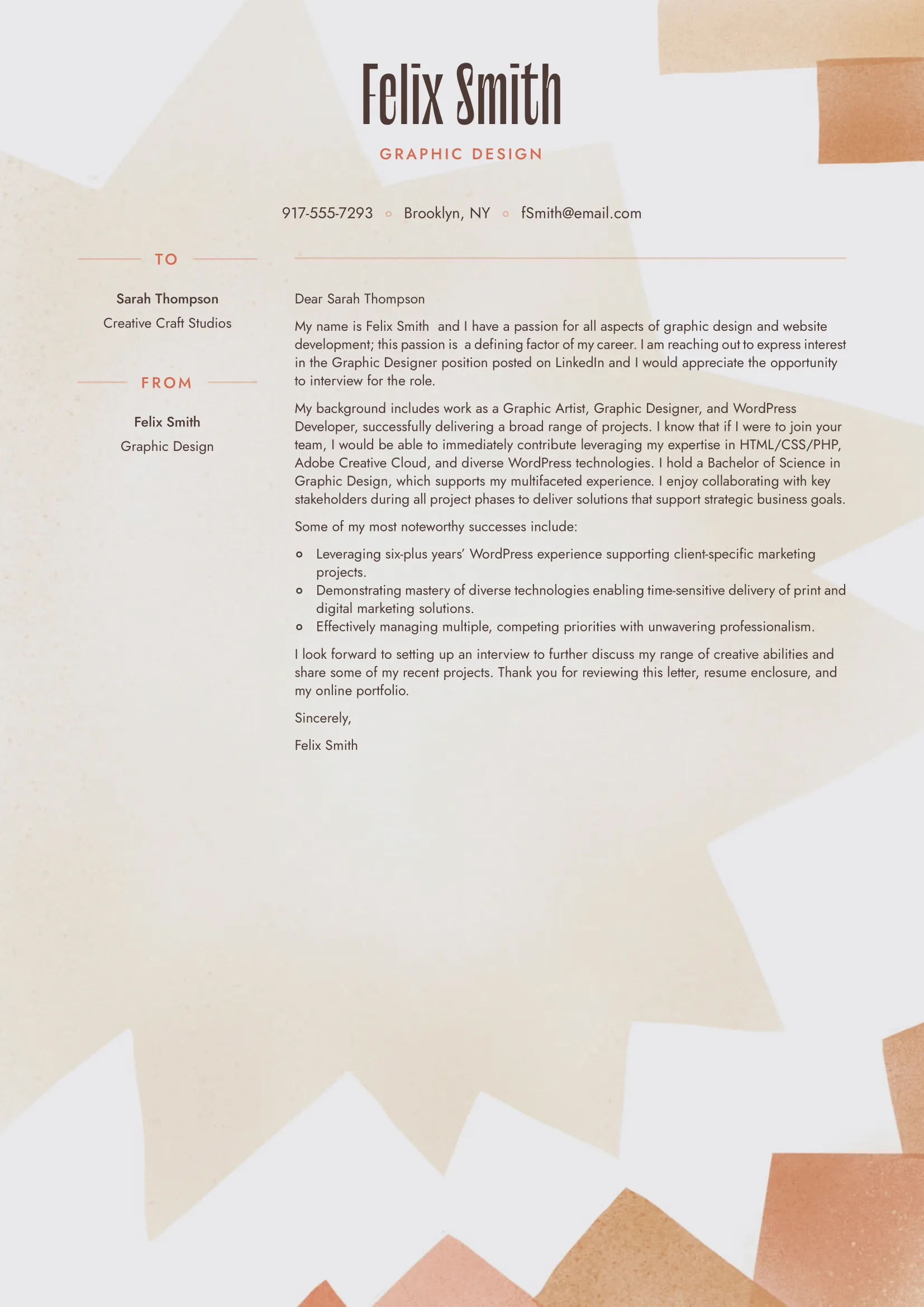Understanding the Importance of a Strong Cover Letter
In the competitive world of graphic design, a compelling cover letter is your first opportunity to make a lasting impression on potential employers. It serves as more than just a formality; it’s a critical tool that can significantly impact your chances of landing an interview. A well-crafted cover letter provides a platform to showcase your personality, passion, and unique approach to design, setting you apart from other applicants. It’s the space where you can explain why you’re the perfect fit for the specific role and company, something a resume alone often fails to achieve. By addressing the employer’s needs and demonstrating your understanding of their brand, you demonstrate that you have taken the time to research and truly care about the opportunity. This proactive approach is often the difference between getting your foot in the door and being overlooked. Consider it your personal sales pitch, carefully tailored to resonate with the reader and generate excitement about your candidacy.
Why Cover Letters Matter for Graphic Designers
For graphic designers, cover letters are even more essential. They offer a chance to articulate your design philosophy and creative process. In a field that values visual communication, your cover letter is an extension of your portfolio; it showcases your written communication skills, attention to detail, and ability to convey a message effectively. It provides context for your portfolio, allowing you to explain the thinking behind your work and highlight relevant projects. A well-written cover letter demonstrates your ability to communicate your design choices and how they align with the company’s goals. It allows you to tailor your message specifically to the job requirements and demonstrate your genuine interest in the position. Moreover, it allows you to explain any gaps in your experience or career changes, giving you an opportunity to contextualize your skills and experience in a way that benefits your application.
Highlighting Your Unique Skills
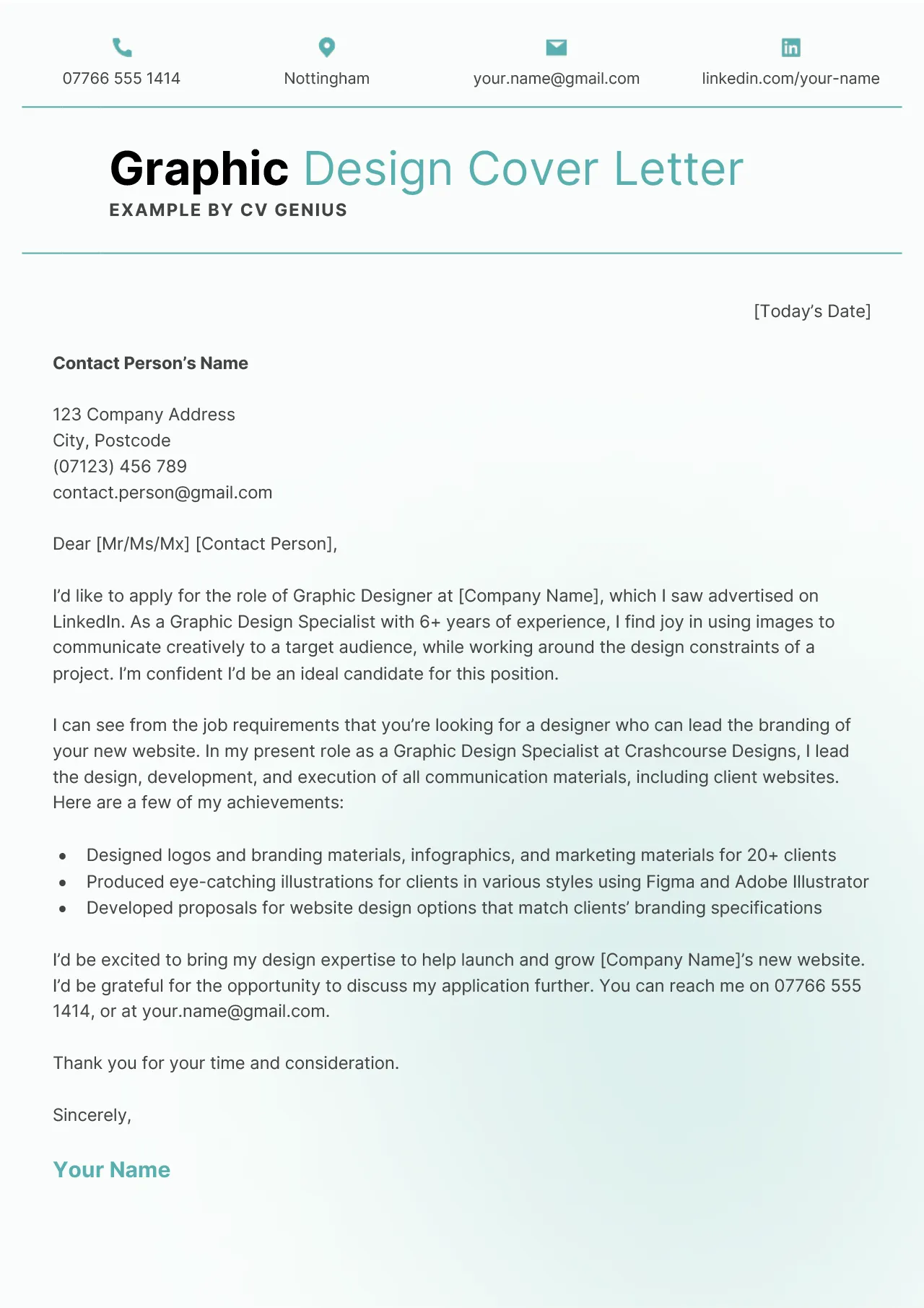
Your cover letter is the perfect space to spotlight the skills that make you a standout graphic designer. Don’t just list your technical proficiencies; demonstrate how you’ve utilized them to achieve tangible results. Quantify your achievements whenever possible. For instance, instead of saying “Improved website design,” you could state “Redesigned the company website, leading to a 20% increase in user engagement.” Mention any specific software or tools you’re proficient in, such as Adobe Creative Suite, Sketch, or Figma, but also emphasize your soft skills, such as communication, problem-solving, and collaboration. Highlight your ability to work under pressure, meet deadlines, and manage multiple projects simultaneously. Illustrate your design process, from initial concept to final execution, and showcase your understanding of design principles, such as typography, color theory, and layout. By aligning your skills with the job description, you show that you’ve carefully considered what the employer is looking for and you are the best fit.
Showcasing Your Design Portfolio
Your portfolio is the cornerstone of your graphic design application, and your cover letter is the guide that leads the reader through it. In your cover letter, tease specific projects from your portfolio that directly align with the job requirements. Briefly describe the project, the problem you solved, and the outcome. This gives the employer a preview of your skills and encourages them to explore your portfolio in greater detail. Make it easy for the hiring manager to view your work by including a direct link to your online portfolio. Ensure your portfolio is well-organized, showcases your best work, and is easily navigable. Provide context for your designs by including brief descriptions of each project, highlighting your role and the goals you achieved. Your cover letter is your chance to tell the story behind your portfolio, emphasizing your creativity, technical skills, and ability to create compelling visuals. Be sure to update your portfolio and cover letter to fit each job.
Cover Letter Formatting Best Practices
The format of your cover letter is just as important as its content. The design should be clean, professional, and visually appealing, reflecting your eye for design. Use a legible font, such as Arial, Helvetica, or Calibri, and maintain consistent formatting throughout the document. Keep your cover letter concise, ideally one page in length. Use clear headings and bullet points to break up text and improve readability. Always tailor your cover letter to the specific job and company, using the company’s name and the hiring manager’s name if possible. Proofread your cover letter carefully for any typos or grammatical errors. A well-formatted cover letter demonstrates attention to detail, an essential quality for a graphic designer. A well-designed and formatted cover letter immediately indicates that the applicant values presentation.
Formatting for Readability and Impact
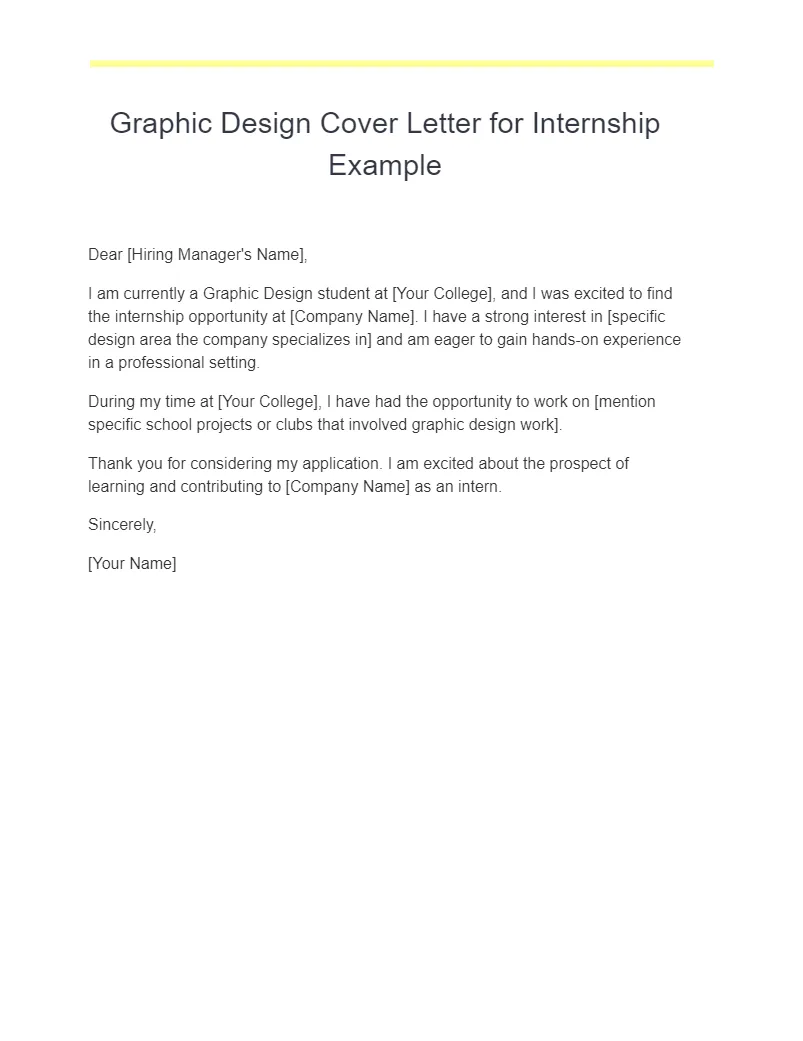
To maximize the impact of your cover letter, focus on readability. Use short paragraphs, clear language, and strong action verbs to engage the reader. Break up large blocks of text with bullet points, numbered lists, and subheadings. Maintain ample white space to avoid overwhelming the reader. Use a professional tone, but let your personality shine through. Highlight your enthusiasm for the role and the company. Use a call to action, such as inviting the employer to review your portfolio or requesting an interview. Proofread your cover letter meticulously to avoid any errors. A clean, well-formatted cover letter is more likely to be read and remembered. Use formatting elements to highlight your achievements and key skills.
Cover Letter Samples Graphic Design That Wins Examples
To illustrate how to write a winning cover letter, here are three sample cover letters for various graphic design roles. These samples highlight different approaches to showcasing your skills and experience. Adapt these examples to fit your background and the specific job requirements, ensuring your cover letter stands out from the competition. Each of the following cover letter samples highlights key sections you will use to show the hiring manager your skills.
Sample 1: The Modern Designer
This sample is tailored for a designer who emphasizes their clean, modern aesthetic and proficiency with current design trends. It highlights their experience with digital design, branding, and UI/UX principles. This designer highlights their understanding of current design trends and digital platforms. Use this sample if you have experience in digital spaces. The goal of this cover letter sample is to show that the applicant keeps up with industry standards.
Sample 2: The Creative Storyteller
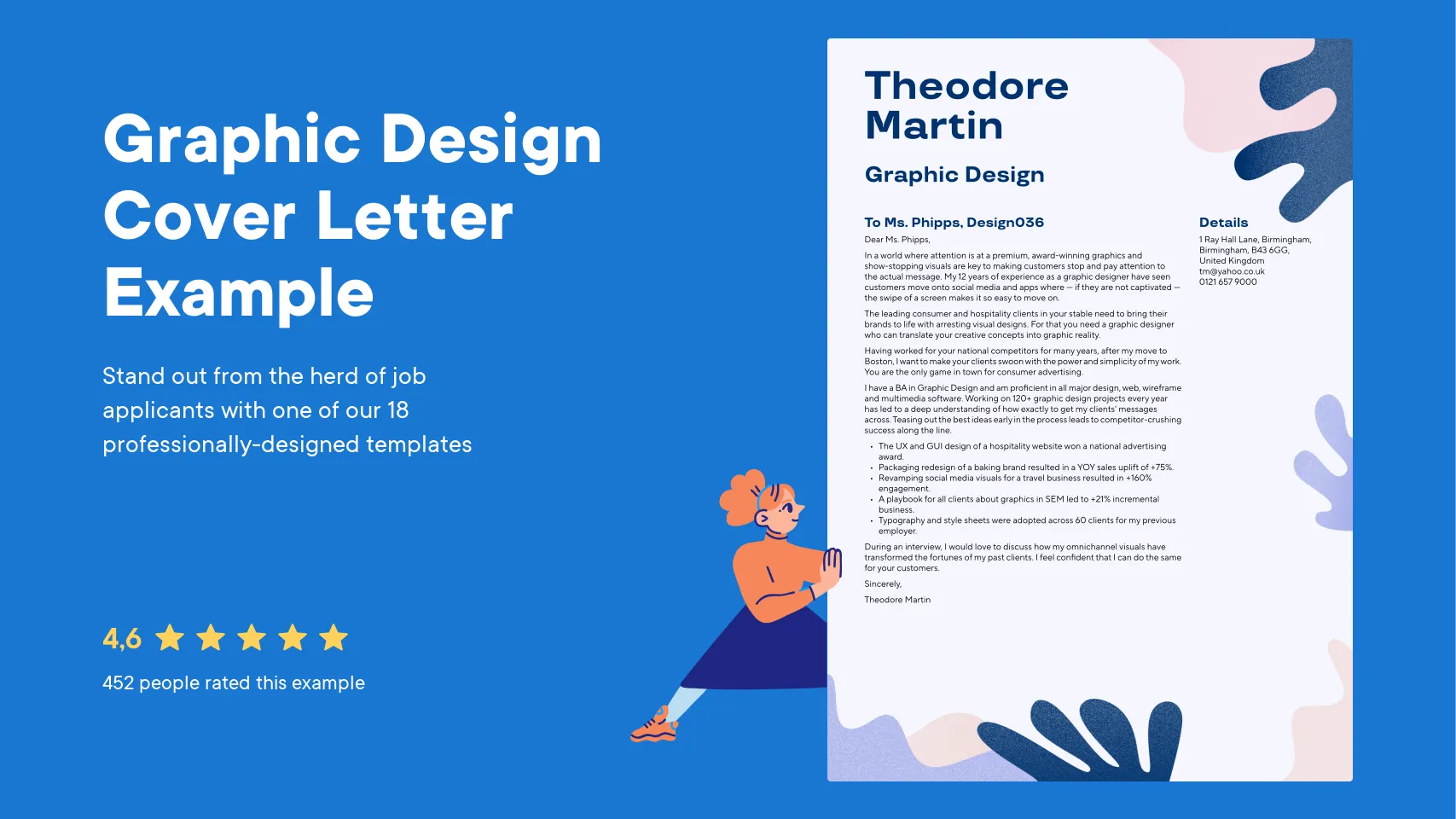
This cover letter is best suited for designers who excel in visual storytelling and brand identity. It emphasizes the ability to create compelling narratives through design and showcases a strong portfolio of branding and campaign work. This sample is designed to show an applicant’s branding skills. Tailor this sample to include your branding and campaign work. Focus on projects where you have created memorable brand identities.
Sample 3: The Technical Expert
This cover letter sample is geared towards designers who have a deep understanding of technical aspects, such as print production, web development, or specific software proficiency. It showcases a strong grasp of technical tools and how to use them effectively. This cover letter is written for technical roles. Highlight your abilities with specific software and print production knowledge. This sample is for highly specialized roles.
Adapting Your Cover Letter to Different Job Types
The key to a successful cover letter is customization. Your approach should vary depending on the type of role you are applying for. Different job types demand tailored approaches to highlight relevant skills and experience. Here’s a guide to adapting your cover letter for different scenarios.
Cover Letters for Agency Positions

When applying to design agencies, emphasize your collaborative abilities and your experience working on diverse projects. Highlight your ability to meet deadlines, work under pressure, and thrive in a team environment. Showcase any experience working with agency clients and understanding their needs. Use the cover letter to show your versatility.
Cover Letters for Freelance Gigs
For freelance positions, focus on your independence, self-management skills, and ability to deliver results. Showcase your portfolio’s breadth and your experience handling a variety of projects. Highlight your ability to work independently and manage your time. Demonstrate your communication skills and your understanding of client relationships. Showcase your ability to produce results.
Cover Letters for Corporate Roles
For corporate positions, highlight your understanding of the company’s brand and your ability to align your design skills with their marketing goals. Show your experience in corporate environments, and demonstrate your ability to work within established brand guidelines. Use the cover letter to show that you can support the company’s marketing efforts.
Common Mistakes to Avoid
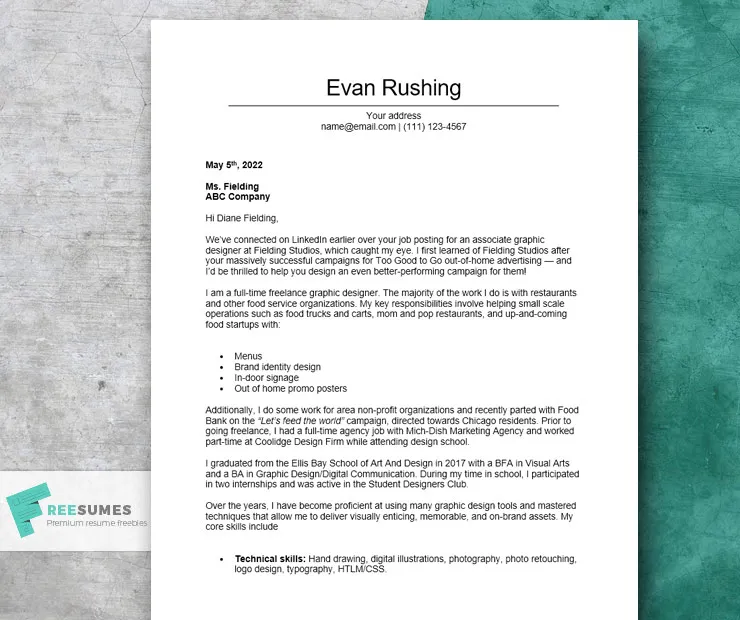
Avoid these common pitfalls to ensure your cover letter makes a positive impression. Paying attention to details is crucial in graphic design, and your cover letter is the perfect opportunity to demonstrate this. Common mistakes can significantly diminish your chances of getting an interview. Let’s look at the most common ones.
Generic Cover Letters
Avoid using generic cover letters that are not tailored to the specific job or company. Always customize your cover letter to match the job description and highlight the skills and experience most relevant to the role. Generic cover letters show that you have not put in the effort to understand the company’s needs and goals. Generic cover letters will fail to grab the reader’s attention, so take the time to create a custom letter.
Typos and Grammatical Errors
Typos and grammatical errors can damage your credibility and professionalism. Always proofread your cover letter carefully and use grammar checking tools to catch any mistakes. Ask a friend or colleague to review your cover letter before submitting it. Proofreading shows that you have an eye for detail. Always proofread to demonstrate your attention to detail.
Conclusion Crafting the Perfect Cover Letter
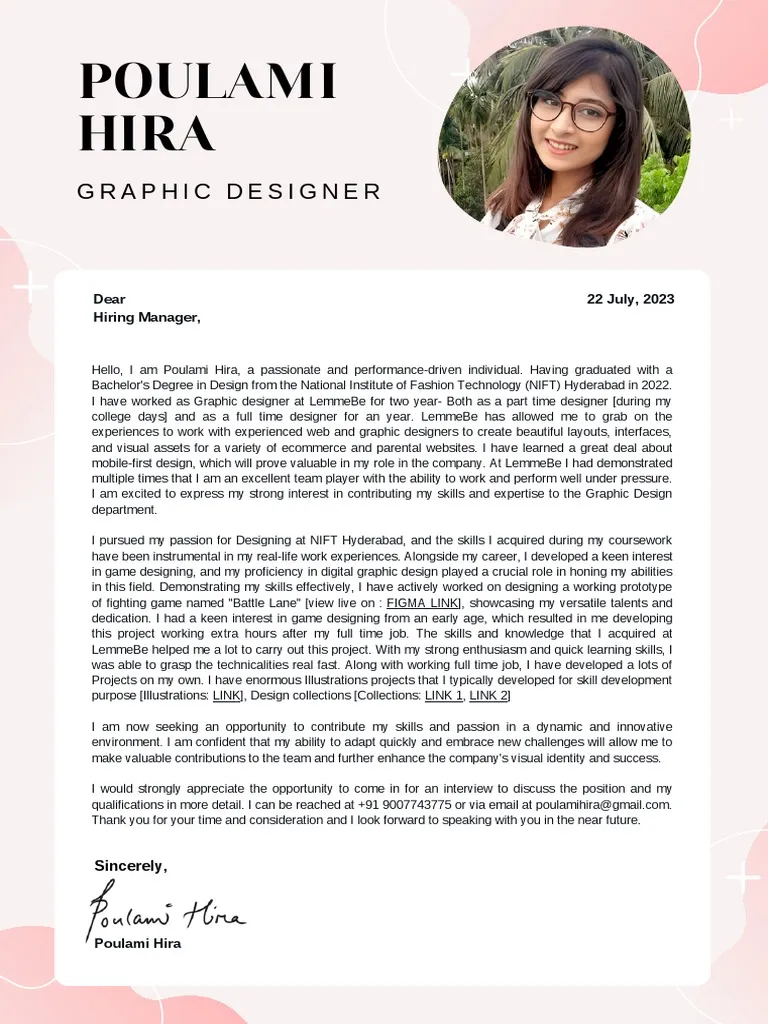
A well-crafted cover letter is a powerful tool in your graphic design job search. By understanding its importance, highlighting your unique skills, showcasing your portfolio, and formatting it effectively, you can significantly increase your chances of landing your dream job. Remember to tailor your cover letter to each specific job, and avoid common mistakes. Follow these tips, and you’ll be well on your way to creating a cover letter that gets you noticed. Good luck with your job search!
